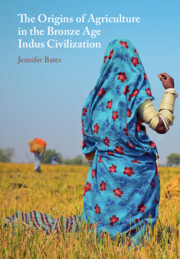Refine search
Actions for selected content:
46 results
3 - ‘The Glory of their times’: Natural Philosophy, the Law, and the Spoils of Empire
-
- Book:
- The University of Cambridge in the Age of Atlantic Slavery
- Published online:
- 12 September 2025
- Print publication:
- 30 October 2025, pp 76-103
-
- Chapter
-
- You have access
- Open access
- HTML
- Export citation
Chapter 7 - Useful Books
- from Part II - Anglophone Literary Forms
-
-
- Book:
- The Cambridge Handbook of Literature and Plants
- Published online:
- 06 February 2025
- Print publication:
- 13 February 2025, pp 131-148
-
- Chapter
- Export citation
Chapter 12 - Plants in the French and Francophone Literary Tradition
- from Part III - Global Regions
-
-
- Book:
- The Cambridge Handbook of Literature and Plants
- Published online:
- 06 February 2025
- Print publication:
- 13 February 2025, pp 233-250
-
- Chapter
- Export citation

The Origins of Agriculture in the Bronze Age Indus Civilization
-
- Published online:
- 13 December 2024
- Print publication:
- 02 January 2025
15 - Clare’s Health
- from Part IV - Influences and Traditions
-
-
- Book:
- The Cambridge Companion to John Clare
- Published online:
- 14 November 2024
- Print publication:
- 21 November 2024, pp 227-240
-
- Chapter
- Export citation
7 - John Clare and the Community of Naturalists
- from Part II - Clare the Naturalist
-
-
- Book:
- The Cambridge Companion to John Clare
- Published online:
- 14 November 2024
- Print publication:
- 21 November 2024, pp 106-119
-
- Chapter
- Export citation
Myth 16 - That Darwin Banished Teleology from Biology
-
-
- Book:
- Darwin Mythology
- Published online:
- 30 May 2024
- Print publication:
- 06 June 2024, pp 181-192
-
- Chapter
- Export citation
11 - Herakleides Kritikos
- from Part III - Hellenistic Period
-
- Book:
- Geographers of the Ancient Greek World
- Published online:
- 25 March 2024
- Print publication:
- 18 April 2024, pp 275-288
-
- Chapter
- Export citation
19 - Geography, Science and Knowledge of the World
- from Part II - Contexts
-
-
- Book:
- The Cambridge Companion to Alexander the Great
- Published online:
- 04 January 2024
- Print publication:
- 18 January 2024, pp 317-330
-
- Chapter
- Export citation
39 - The Essay and the Anthropocene
- from Part IV - Toward the Contemporary American Essay (2000–2020)
-
-
- Book:
- The Cambridge History of the American Essay
- Published online:
- 28 March 2024
- Print publication:
- 14 December 2023, pp 668-682
-
- Chapter
- Export citation
Introduction to Part I
- from Part I - Before Breadfruit
-
- Book:
- A Caribbean Enlightenment
- Published online:
- 14 September 2023
- Print publication:
- 05 October 2023, pp 21-29
-
- Chapter
- Export citation
Conclusion
- from Part III - Inventing Settler Science
-
- Book:
- The Antipodean Laboratory
- Published online:
- 21 September 2023
- Print publication:
- 05 October 2023, pp 247-259
-
- Chapter
- Export citation
5 - Collecting Practices
- from Part III - Inventing Settler Science
-
- Book:
- The Antipodean Laboratory
- Published online:
- 21 September 2023
- Print publication:
- 05 October 2023, pp 181-211
-
- Chapter
- Export citation
16 - The Sublime in American Romanticism
- from Part II - Romantic Sublimes
-
-
- Book:
- The Cambridge Companion to the Romantic Sublime
- Published online:
- 06 July 2023
- Print publication:
- 20 July 2023, pp 207-220
-
- Chapter
- Export citation
4 - 1818
-
- Book:
- The Vanished Settlers of Greenland
- Published online:
- 01 June 2023
- Print publication:
- 06 July 2023, pp 142-180
-
- Chapter
- Export citation
Chapter 15 - Science
- from Part III - Culture
-
-
- Book:
- Chekhov in Context
- Published online:
- 16 February 2023
- Print publication:
- 23 February 2023, pp 116-122
-
- Chapter
- Export citation
Chapter 4 - Eudaimonia (Happiness)
- from Part I - Shakespeare and Virtue Ethics
-
-
- Book:
- Shakespeare and Virtue
- Published online:
- 19 January 2023
- Print publication:
- 26 January 2023, pp 44-52
-
- Chapter
- Export citation
Reviving botany in the curriculum: the botanical journey of two Western Australian early childhood teachers
-
- Journal:
- Australian Journal of Environmental Education / Volume 39 / Issue 2 / June 2023
- Published online by Cambridge University Press:
- 11 October 2022, pp. 166-180
-
- Article
-
- You have access
- Open access
- HTML
- Export citation
7 - Great Exaptations: On Reading Darwin’s Plant Narratives
- from III - Accessing Nature’s Narratives
-
-
- Book:
- Narrative Science
- Published online:
- 16 September 2022
- Print publication:
- 06 October 2022, pp 143-163
-
- Chapter
-
- You have access
- Open access
- HTML
- Export citation
17 - A Box of Tea and the British Empire
- from Part IV - Small Things on the Move
-
-
- Book:
- Small Things in the Eighteenth Century
- Published online:
- 29 September 2022
- Print publication:
- 29 September 2022, pp 274-290
-
- Chapter
- Export citation
